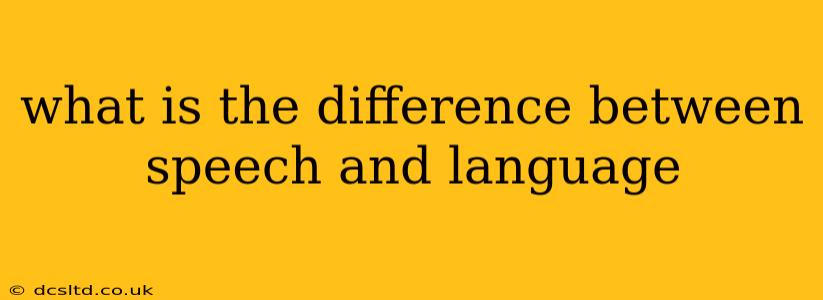What's the Difference Between Speech and Language?
The terms "speech" and "language" are often used interchangeably, but they represent distinct, yet interconnected, aspects of communication. Understanding their differences is crucial for appreciating the complexities of human communication and identifying potential developmental challenges.
Language is a complex system of symbols (words, signs, gestures) that we use to convey meaning. It's a cognitive process encompassing our understanding and use of vocabulary, grammar, and syntax to formulate thoughts and ideas. Language is the underlying blueprint; it's the system of rules and meanings that allow us to communicate. Think of it as the software of communication. Language can be expressed in many modalities, not just speech.
Speech, on the other hand, is the oral expression of language. It's the physical act of producing sounds to communicate using the vocal tract – including the lungs, larynx, tongue, teeth, and lips. It's the motor skill involved in articulating words and sentences. Think of it as the hardware of communication. Speech relies on the physical ability to control and coordinate these muscles to produce the sounds that make up spoken language.
Here's a table summarizing the key distinctions:
| Feature | Language | Speech |
|---|---|---|
| Nature | Cognitive, symbolic system | Motor skill, physical act |
| Modality | Can be expressed orally, written, signed, etc. | Primarily oral |
| Components | Vocabulary, grammar, syntax, semantics | Articulation, voice quality, fluency |
| Impairment | Aphasia (difficulty understanding/using language) | Dysarthria (muscle weakness affecting speech), Apraxia of speech (difficulty planning and coordinating movements for speech) |
What are some common misconceptions about the difference between speech and language?
Many people confuse the two, believing that if someone can speak, they automatically possess strong language skills. This isn't always true.
-
Someone can have excellent language skills but poor speech: A person might have a fully developed understanding of grammar and vocabulary (strong language) but have difficulty articulating words due to a speech disorder like dysarthria (weak muscles) or apraxia of speech (difficulty planning speech movements). They know what to say, but their ability to say it is impaired.
-
Someone can have good speech but limited language skills: A person might be able to speak fluently (good speech) but lack a rich vocabulary, struggle with grammatical structures, or have difficulty understanding complex language (limited language). Their speech production is fine, but their comprehension and expression of language are underdeveloped.
How does this distinction help in diagnosing communication disorders?
Differentiating between speech and language is crucial for diagnosing and treating communication disorders. A speech-language pathologist (SLP) assesses both speech and language skills to determine the specific nature and severity of any impairment. This allows for targeted intervention, focusing on the specific areas needing improvement – whether it’s improving articulation, expanding vocabulary, or addressing grammatical errors.
Can you provide examples of different types of speech and language disorders?
Yes, absolutely. Here are a few:
- Aphasia: A language disorder affecting the ability to understand or express language due to brain damage, often caused by stroke.
- Dysarthria: A motor speech disorder characterized by slurred or slow speech due to weakness or incoordination of the muscles used for speech.
- Apraxia of speech: A motor speech disorder in which the person has difficulty planning and coordinating the muscle movements needed for speech, even though the muscles themselves are not weak.
- Stuttering: A fluency disorder characterized by interruptions in the flow of speech, including repetitions, prolongations, and blocks.
- Specific Language Impairment (SLI): A language disorder affecting language development without other obvious causes like hearing loss or intellectual disability.
Understanding the difference between speech and language is fundamental to recognizing and addressing communication challenges effectively. It highlights the intricate interplay between cognitive processes and physical abilities in creating and conveying meaningful communication.
